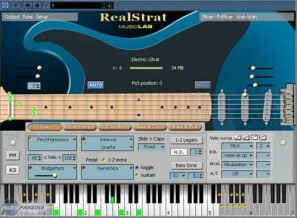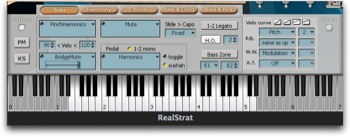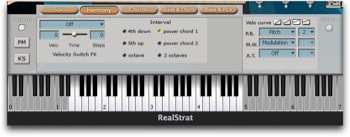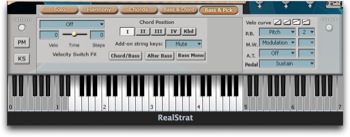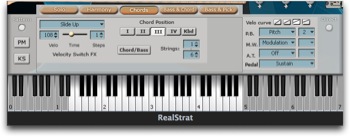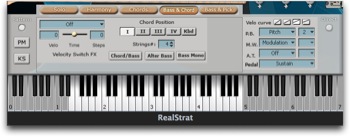MusicLab, the editor of RealGuitar, has released RealStrat, a virtual instrument that uses a combination of samples and in-house technology to emulate the sound and feel of the illustrious Fender model.
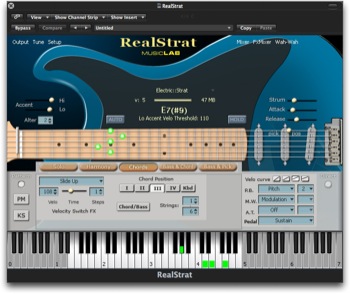 |
The fundamental differences in playing techniques between keyboard and guitar have been one of the major issues whenever trying to program realistic guitar parts. To compensate for these problems, there are several solutions: for instance, you can use loops that include markers and information about time stretch and pitch shift (in ACID, Rex or Apple Loops formats), or use audio files with software like Melodyne, when the audio engine isn’t already included in the virtual instrument (Liquid Instrument by Ueberschall, for instance). You may also play in real time or program parts with sampler libraries such as Prominy, Vienna, Sonic Implants, etc., which have become more and more convincing thanks to new possibilities offered by scripts (such as in Native Kontakt). You can also use dedicated virtual instruments such as Virtual Guitarist, Slayer, ManyGuitar, Strum Acoustic GS-1, Acoustic Legends HD, DirectGuitar 2.0, Chris Hein-Guitars or RealGuitar.
The latter has been a kind of pioneer, including Rhythm’n’Chords technology, which allows you to create realistic rhythmic parts with its blend of sophisticated chord recognition, MIDI files and samples. Real Strat is the second instrument that uses this concept.
Presentation
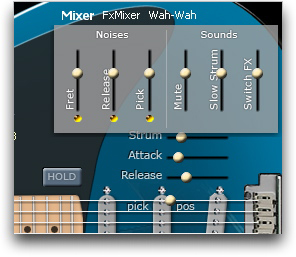 |
On the DVD, you’ll find the RealStrat installer, a demo version of Real Guitar and Amplitube 2 Duo, an OEM version of the IK Multimedia amp simulation program, offering 2 amps, 2 preamps and EQ, 2 cabinets, 2 stomp boxes (Wah and overdrive) and other refinements, usable as a plug-in or in standalone mode; in short everything to fine tune the RealStrat sound. Installation is an easy process (if you’re using Leopard, you’ll have to download a patch). At the end of the installation, you will be prompted to set the Bank Manager, which installs the library according to the specified sample rate(s). You can use RealStrat in demo mode for one month, after which you’ll have to register. The editor will send a special file by e-mail (rlst.key) which unlocks the software. You’ll also find the serial for Amplitube Duo in the e-mail.
The software has three windows, the first being the instrument itself, the second gives access to the pattern library (PM button), the last is dedicated to the Keyswitch settings (KS button). Functions are accessible through pull-down menus or pop-up windows. The instrument window is divided into two parts: above, the guitar neck are the various parameters and sub-windows. Underneath, you’ll find MIDI parameters, access to the patterns and KeySwitches and other options.
You’ll start by setting your audio and MIDI interfaces. Then, in the upper left side, Output will let you set the output level and apply an EQ (Low and High). Though volume adjustment can be useful, you’d be better off not touching the EQ… The Tune window allows you to set the instrument tuning and Modulation (with optional Sync). Setup give access to several parameters, the most important being Chord Detect Time. It’s up to you to make your own settings, according to your playing technique (in particular the way you play chords sequences). On the right, there’s the Mixer and the respective volumes for the noises and sounds that add to the instrument’s realism (fret noises, release, pick, mutes, etc.). It’s the same with the FX Mixer, handling muting, harmonics, etc.
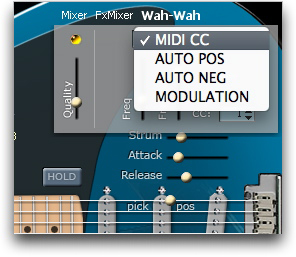 |
RealStrat also includes a well designed Wah-Wah. It offers 4 control modes, via MIDI CC, in Auto mode (positive or negative) or via modulation, with settings for frequency, MIDI CC number, filter slope, modulation etc. If you play it with the Mod Wheel or even better with an expression pedal, it works fine…
Below are settings for strumming speed, attack and release. In the center, in addition to info on chords and parameter values, are two buttons: Hold (the chord is held even if you’ve released the keys) and Auto (which activates the virtual capo). Finally, on the left you’ll find settings for Accent (adjusting the various velocity thresholds) and Alter which defines the number of samples used for repeated notes, thus avoiding the machine-gun effect.
Library
The library loads automatically when you open RealStrat (the library is 948MB in 48kHz). You can choose between 15 pick positions, that are a kind of compromise between the different sounds achieved by the mic selector and the place where you hit the strings. The result seems to be a blend of samples and Filtering/Eqing. More can’t be said since Sergey Egorov, “father” of RealStrat, has remained silent on his industrial secrets. The library is of good quality, since every note has been sampled from every fret of each string. You’ll hear all the sonic qualities of a real Stratocaster, such as the well-known “twang”, even if the library can’t compete with huge libraries such as SC Electric Guitar by Prominy, for instance (64GB, 123000 samples…). However, the concept isn’t the same.
In Direct mode, you can play all the sample sets, from Full Sound to Mutes, Bridge Mutes, Harmonics and Pinch Harmonics and various noises (Slap, Scrapes, Release and Fret), by just switching from one MIDI channel to another. If you can create and set a multi-instrument in your sequencer, you’ll be able to select the sounds much faster without the need to load the plug-in X times on different tracks, and recording them in successive passes using the different channels.
Each mode uses a keyboard that is divided into three zones, with chord recognition and access to the six strings, the alternate notes, strums, mutes, etc. Each mode offers a Main zone (between E1 and B4), which is dedicated to chord recognition and chromatic playing, and two command zones (from C0 to D#1 and from D#5 to G6 on the plug-in keyboard, but really from C-2 to D#1 and D#5 to C7 in reality). These allow you to play with various programmed techniques: once the chord is recognized, you can trigger up and down strokes, arpeggios, different strumming according to velocity and mutes. Generally, the white keys are Repeat keys (which trigger played notes or chords) and black keys are Mutes. To add even more realism, almost two octaves (from C-2 to A#-1, called Strokes) trigger extra playing techniques: various up and down-strokes, different mutes, chromaticism, etc. All you have to do is record the song harmonies and then after (or simultaneously) apply the various techniques.
On the right are the typical MIDI parameters: velocity curve, Pitch Bend, Mod Wheel and after-touch. These allocations vary according to the selected Mode. Among the most interesting, we can cite the Pitch or Mod Wheel MonoBend, where only the lower note (or the first bent and held note) of a chord will be modified and the Feedbacker, accessible via aftertouch, which adds the same note or its fifth on two octaves (three for the fifth). We don’t know if it’s sample or synthesis based, but it’s really impressive when used with an amp simulator. You can also allocate the wha-wha, the Open Strings triggering or the Chucka (muted chords, perfect for “ghost” rhythms) to an expression pedal.
Special Features
 |
Let’s detail the triggers that are specific to each mode: in Solo mode, you can access two different sounds via velocity (harmonics, mutes, palm mutes, tremolo, slide, wah, violining, chucka, repetition, etc.), set the Legato by half and whole tone intervals, trigger a sound via a sustain or switch pedal, specify a zone for alternate bass playing…
In Harmony mode, you set the interval added to the played note (octave, two octaves, upper fifth, lower fourth, Power Chord 1 or 2), with an effect triggered by velocity (Slide Up or Down).
In Chords, you select the desired inversion (I to IV) or a rendering of what you are playing on the keyboard (Kbd knob). The latter sometimes causes some unreal chord changes. You define how many strings are played (from 1 to 6) and you still have the velocity triggered effect option (Strum or Slide). In Bass & Chord mode, there are the same inversion settings, but on only five strings, the sixth being dedicated to the bass line note. Alter Bass alternates fundamental and fifth and with Bass Mono you won’t be able to play two notes on the same string. In Bass & Pick mode, settings are the same, with the exception of the number of strings.
The Solo mode is strangely enough a… polyphonic mode, which lets you play chords or melodies. The chords will sound as played on the master keyboard, but will benefit from a guitar sounding inversion if triggered by the Repeat keys. If you allocate various playing techniques to Keyswitches and activate them (small yellow LED) and the KS mode (KS knob), it’s relatively easy to emulate realistic solo phrases in real time. Or by programming them if you’re not a good keyboard player. One nice detail: to quickly check what is active or not when in KS mode, if a Keyswitch is activated, a LED is added to the corresponding key, that key becoming blue when the Keyswitch is used. Please note that the KeySwitches are available in Solo mode only.
Three triggering modes are available: Toggle (the KeySwitch remains active even if the key is released), Through (which allows the key to act as a KeySwitch and as a Repeat Key simultaneously) and Sustain (which adds the sustain possibility to the KeySwitch). MusicLab has done a great job on these features: you can activate the three modes at the same time, and the implementation has been done according to guitar playing limitations: you will not be able to do a bend on an open string or make slides from a note to another on two different strings.
Another strong point is the Floating Fret Position feature. You can place a virtual capo on the first five strings (right-click on the guitar neck), which is really handy when you only have a small MIDI keyboard. If you click on the Auto button, the capo will automatically place itself according to what you are playing. When manually activated, it doesn’t allow you to play under the capo limit.
Playing chords
Even though the Solo and Harmony modes let you create realistic guitar parts, RealStrat is at its best when it’s time to emulate chord playing. For that purpose, the editor has included the chord recognition and rendering modes: Chords, Bass & Chords and Bass & Pick. RealStrat perfectly analyses the chords played on a keyboard and above all places them as a guitarist would play them. This ensures an authentic “feel” with typical guitaristic inversions, repetitions and omissions of notes. RealStrat can detect 26 chord types which are detailed in the .PDF manual, with information about mandatory and optional notes to use for correct analysis.
Even if all chords aren’t recognized, it’s easy to use chord substitutions, and to limit the number of strings in order to avoid unwanted notes. It works quite nicely, and the chord and note monitoring on the virtual neck (big green spots) helps to better understand a real guitar. In Chords mode, RealStrat can play four different inversions, thanks to Chord Position (from I to IV), not including the Kbd option. Once the chord is recognized, you can play it with the Repeat keys, whose velocity determines the number of strings that are used. With proper aftertouch, modulation and KeySwitch settings, you can make surprisingly realistic rhythmic parts, all the more so since every parameter can be automated, you can change crucial settings in real time to cover any scenario (change inversion II to IV, for example).
The two other modes separately handle bass and chord notes and extensions. In Bass & Chords, the Repeat keys play the chords on five strings and you can alternate the bass notes. In Bass & Pick, white keys from E5 to C6 correspond to the six strings and allow you to play arpeggios, while black keys trigger a Unison (different sample) or a lower chromaticism. Thus you can play folk or country or any other rhythmic figure that would hardly be convincing if directly played from a keyboard. Here, with Repeat and Unison keys, it works right away.
Groove library
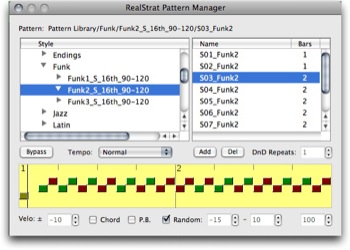 |
Another RealStrat asset is the Rhythm Pattern Library which covers most musical styles. These MIDI files, lasting one to eight measures, send a series of notes to the Strokes, Repeat and Mutes zones, thus forming complete rhythmic parts (strum, mute, arpeggio, etc.). Since RealGuitar2, the library has been included in the plug-in’s interface, which not only allows you to find the appropriate pattern immediately, but also to use it right away, even if you’re using the standalone version.
You click on PM to launch the Manager window and on Pattern if you want to activate the pattern, which starts to play as soon as you hit a chord or a note on the keyboard. 19 styles are available, each divided into three to nine sub-families, each one of the latter including several variations: the library offers 1250 files. These files can be used in every mode of RealStrat, since they only gather trigger events, which remain the same from one mode to another. The result will of course be different if you are in Solo or Chords mode.
 |
The Pattern Manager interface allows you to play the file at normal speed (set by the host or by a cursor in standalone), as well as double or half-speed. You can also adjust the velocity (fixed or according to the one sent by the keyboard), or assign it to the Pitch Wheel for continuous change or randomize several settings. The quality and realism of the patterns are variable, however the concept works perfectly, some rhythms are really amazing. Generally, you may regret that the quantization is a bit too stiff, meaning that you will have to tweak the trigger notes in your MIDI editor.
Of course, the main interest of this library is that you can use it in your favorite DAW. There, everything is possible. First, you export the MIDI file by a simple drag’n’drop (velocity settings are included). You can then modify everything, from the velocity to the quantization and change some trigger notes, and therefore playing techniques. You can also create you own patterns by combining Repeat, Mutes and Strokes trigger notes, then import the pattern into the Pattern Manager (in the specified folder). The .PDF manual gives the complete Strokes nomenclature as well as the complete automation implementation.
The library’s concept, the number of MIDI files and its modification and creative potential make it one of the most powerful tools dedicated to guitar rhythms, if not the most powerful, as there’s no limit other than the user’s imagination to create new patterns in a very simple and easy way.
In Conclusion
This nice sampling job done with a real Strat, even if it can’t compete with gigantic libraries, allows you to meet the needs of most scenarios, whether it’s creating rhythmic backgrounds or creating solos. The strength of this plug-in is undoubtedly it’s versatility and flexibility thanks to the trigger zone concept. Bends, mutes, repetitions, slides, hammer-ons and other playing techniques are perfectly implemented and triggered. The versatility of the groove library also allows you to quickly pick up a pattern, and then make all kinds of changes, with a whole set of commands and variations. Anyway, this plug-in’s strong point is in the creation of rhythm. This time, no demos, but we invite you to check the editor’s site where you’ll find audio and video examples.
It’s really hard to find something to criticize: Both concept and technical achievement are near perfect. RealStrat does what it is supposed to do perfectly without any bugs. The sample library may sound a bit cold, needing the help of an amp simulator. Fortunately, MusicLab has partnered with IK Multimedia and offers Amplitube Duo. RealStrat can also benefit from experimentation with various plug-in combinations, since the samples are really raw. You will need some practice to achieve convincing real time performances as well as to program personal patterns.
Before concluding, let it just be said: RealStrat will never replace a sensitive, inventive musician and his guitar… Having said that, RealStrat is unquestionably the best virtual instrument dedicated to a Strat electric guitar. It’s a real instrument, playable, modifiable, and not just a simple loop player or sample library. You can use it to quickly record background tracks, to easily lay down rhythmic ideas or the basis of a song, and even final tracks if you take the time to refine your sequences.
[+] Concept
[+] Stability
[+] Ease of Use
[+] Powerful and accurate chord recognition algorithm
[+] Strokes
[+] Floating Fret
[+] Total automation
[+] Realism of the sound and of the playing techniques
[+] 1250 MIDI Patterns
[+] Amplitube Duo as a bonus
[-] May sound a bit “cold”
[-] Needs an amp simulator (luckily, there is one…)
[-] No finger-picking samples
[-] No new MIDI patterns


